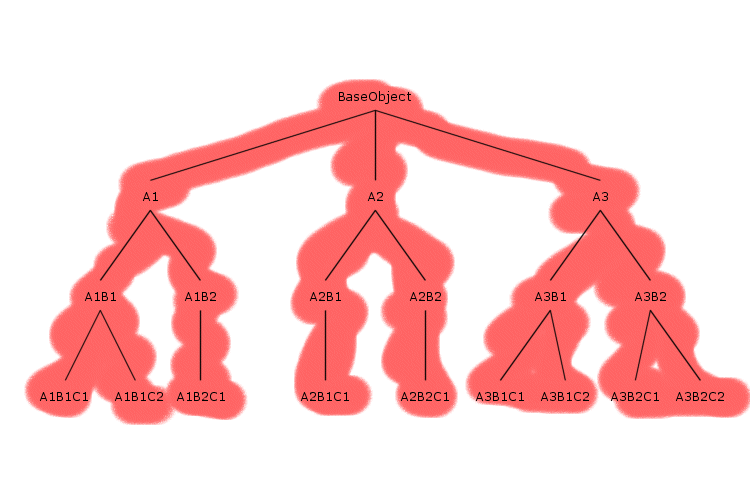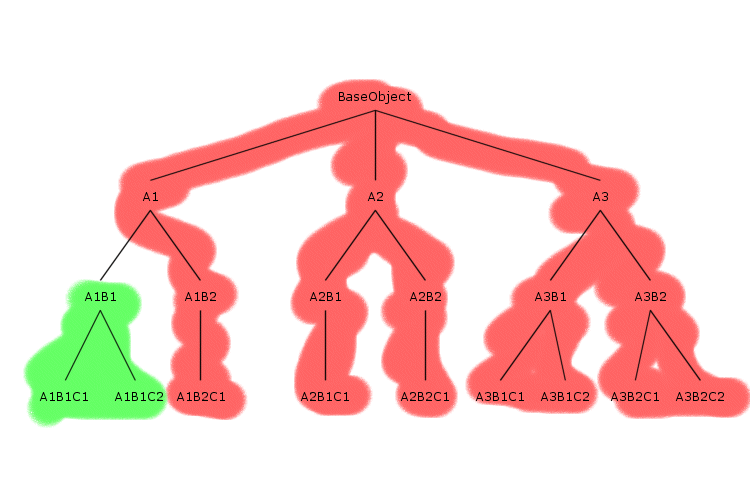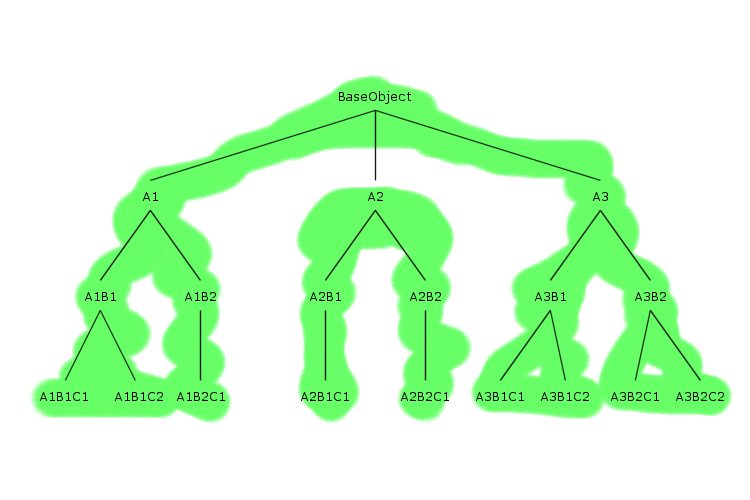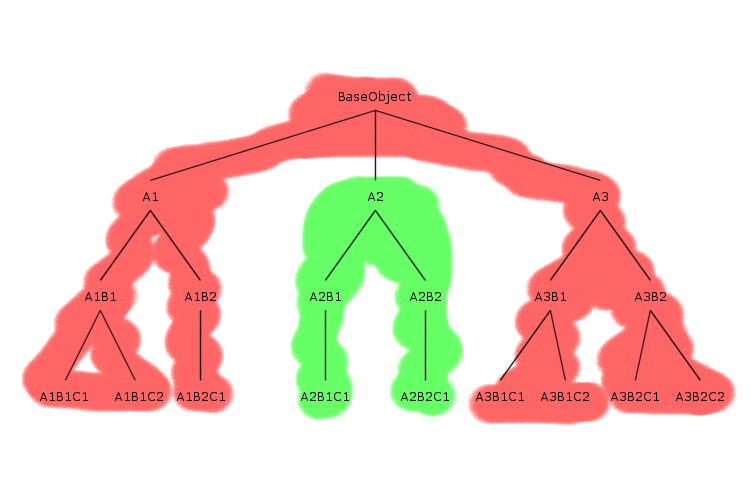| Version 6 (modified by landauf, 18 years ago) (diff) |
|---|
ClassTreeMask
Description
The ClassTreeMask defines a mask that includes or excludes branches and single classes in the class-tree. You can think of the ClassTreeMask like a mask in computer graphics: A mask is a black/white picture where black means invisible and white means fully visible. That way you can show some parts of an image and hide others. The ClassTreeMask does the same with the class-tree, but show means include and hide means exclude. An unmodified mask shows everything / is white / includes the BaseObject (those statements are equivalent). Notation: Including or excluding a class is denoted as "adding a new rule".
The class-tree starts with the BaseObject but has some additional Interfaces that are parents of some subclasses (or "nodes" in the speak of tree-structure). Because we can't include or exclude classes directly, we use the corresponding Identifiers instead. In the following we'll speak about "classes" but implicitly mean "the Identifiers of those classes".
Including a class means: "The whole branch starting with this class gets included", unless you didn't set the overwrite flag to false. Including a class without overwriting means: "Include the whole branch starting with this class but don't include previously excluded classes". The same aplies for excluding.
After including/excluding a class, the ClassTreeMask is scanned for useless rules. If you include the BaseObject and include a subclass of BaseObject too, this brings no new information, so the inclusion-rule of the subclass can be discarded. Only rules that change the state are saved. You can turn of this cleanup by setting the clean flag to false. Warning: This could change the meaning of your mask when you add further rules with overwrite set to false. If, in our example, the subclass of BaseObject was included without clean and afterward you exclude the BaseObject without overwrite, the subclass stays included. You'll find some examples for this in the corresponding section of this page.
It's also possible to include/exclude only a single class wihtout changing the rule for following classes. This is achieved with the includeSingle/excludeSingle functions.
Including/excluding interfaces is a bit different, because interfaces aren't directly in the class-tree. Instead the ClassTreeMask will apply the rule for all direct parents of the interfaces. If you set overwrite to false, only direct parents without an explicit rule apply the new rule. This may sound difficult, but it's really intutive. Just look at the examples.
Functions
- Branches:
- include(class, overwrite, clean): Includes class and all following classes. If overwrite is false, only classes that weren't explicitly excluded previously are included (default is true). If clean is true, only relevant rules stay in the branch (default is true).
- exclude(class, overwrite, clean): Excludes class and all following classes. If overwrite is false, only classes that weren't explicitly included previously are excluded (default is true). If clean is true, only relevant rules stay in the branch (default is true).
- Single classes:
- includeSingle(class, clean): Includes class without changing the rule for following classes. If clean is true, only relevant rules stay in the branch (default is true).
- excludeSingle(class, clean): Excludes class without changing the rule for following classes. If clean is true, only relevant rules stay in the branch (default is true).
- Tree:
- clean(): Cleans the ClassTreeMask by droping all useless rules, where "useless" means: They add no new informations to the mask (because a rule applied to a parent already sais the same).
- reset(): Deletes all rules and includes everything.
Operators
It's possible to calculate with masks in the meaning of set-theory, so you can create unions (+), intersections ![]() , differences (-) and complements
, differences (-) and complements ![]() by using the corresponding operators.
by using the corresponding operators.
- Union: Every class that is included in at least one of the two masks will be included in the resulting mask, all others are excluded (or).
- operator+, operator|, operator+=, operator|=
- Intersection: Every class that is included in both masks will be included in the resulting mask, all others are excluded (and).
- operator*, operator&, operator*=, operator&=
- Difference: Every class that is included in the left mask but not in the second mask will be included in the resulting mask, all others are excluded.
- operator-, operator-=
- Complement: Every class that is excluded in the mask will be included in the resulting mask and vice versa (not).
- operator!, operator~
- Exclusivity: Every class that is included in exactly one of the two masks will be included in the resulting mask, all others are excluded (xor).
- operator^, operator^=
Examples
Include and Exclude
// Create a new mask - at the beginning everything is included ClassTreeMask mymask;
// Now exclude A2 mymask.exclude(Class(A2));
// Include A2B1C1, A2B2C1 and A3B2 mymask.include(Class(A2B1C1)); mymask.include(Class(A2B2C1)); mymask.include(Class(A3B2));
Include single and exclude single
// Create a new mask and exclude only A2 but noth the following classes ClassTreeMask mymask; mymask.excludeSingle(Class(A2));
Overwrite true and false
// Create a new mask, exclude A1 but include A1B1 ClassTreeMask mymask; mymask.exclude(Class(A1)); mymask.include(Class(A1B1));
// Now exclude the BaseObject with overwrite = true (this is default) // -> everything is now excluded mymask.exclude(Class(BaseObject), true);
// If we instead exclude the BaseObject with overwrite = false // -> A1B1 stays included ClassTreeMask mymask; mymask.exclude(Class(A1)); mymask.include(Class(A1B1)); mymask.exclude(Class(BaseObject), false);
Clean true and false
// Create a new mask and explicitly include BaseObject // Then include A2 too with clean = true (this is default) // The resulting mask includes everything - the include rule of A2 had no effect ClassTreeMask mymask; mymask.include(Class(BaseObject)) mymask.include(Class(A2), true, true)
// Now exclude the BaseObject without overwrite // This excludes everything, because only the include rule of of BaseObject was // saved, and now this rule was changed to exclude. mymask.exclude(Class(BaseObject), false)
// Instead of this we create a new mask again and explicitly include BaseObject // This time include A2 with clean = false // The resulting mask includes still everything, but the include rule of // A2 is saved ClassTreeMask mymask; mymask.include(Class(BaseObject)) mymask.include(Class(A2), true, false)
// Now exclude the BaseObject without overwrite // This excludes everything except A2, because the include rule of A2 was saved // and not overwritten mymask.exclude(Class(BaseObject), false)
Inclusion and exclusion of interfaces
Attachments (19)
- example1.gif (38.8 KB) - added by landauf 18 years ago.
- example2.gif (41.9 KB) - added by landauf 18 years ago.
- example3.gif (39.7 KB) - added by landauf 18 years ago.
- example4.gif (38.2 KB) - added by landauf 18 years ago.
- example5.gif (39.2 KB) - added by landauf 18 years ago.
- example6.gif (38.2 KB) - added by landauf 18 years ago.
- example7.gif (39.6 KB) - added by landauf 18 years ago.
- example8.gif (36.2 KB) - added by landauf 18 years ago.
- example9.gif (40.3 KB) - added by landauf 18 years ago.
- example10.gif (42.0 KB) - added by landauf 18 years ago.
- example11.gif (44.8 KB) - added by landauf 18 years ago.
- example12.gif (44.2 KB) - added by landauf 18 years ago.
- testclass_tree_mask1.gif (42.6 KB) - added by landauf 18 years ago.
- testclass_tree_mask2.gif (39.2 KB) - added by landauf 18 years ago.
- testclass_tree_mask_1or2.gif (35.9 KB) - added by landauf 18 years ago.
- testclass_tree_mask_1and2.gif (33.3 KB) - added by landauf 18 years ago.
- testclass_tree_mask_1minus2.gif (34.0 KB) - added by landauf 18 years ago.
- testclass_tree_mask_not1.gif (36.8 KB) - added by landauf 18 years ago.
- testclass_tree_mask_1xor2.gif (34.2 KB) - added by landauf 18 years ago.
Download all attachments as: .zip




















